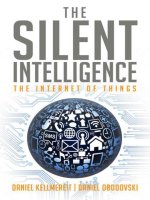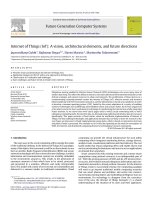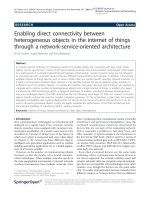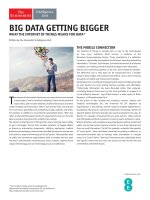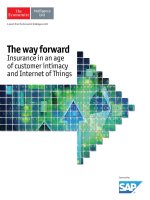Demystifying internet of things security successful iot deviceedge and platform security deployment
Bạn đang xem bản rút gọn của tài liệu. Xem và tải ngay bản đầy đủ của tài liệu tại đây (27.35 MB, 338 trang )
SunilCheruvu,AnilKumar,NedSmithandDavidM.Wheeler
DemystifyingInternetofThingsSecurity
SuccessfulIoTDevice/EdgeandPlatformSecurity
Deployment
SunilCheruvu
Chandler,AZ,USA
AnilKumar
Chandler,AZ,USA
NedSmith
Beaverton,OR,USA
DavidM.Wheeler
Gilbert,AZ,USA
Anysourcecodeorothersupplementarymaterialreferencedbytheauthorinthisbookis
availabletoreadersonGitHubviathebook’sproductpage,locatedatwww.apress.com/9781-4842-2895-1.Formoredetailedinformation,pleasevisithttp://www.apress.com/sourcecode.
ISBN978-1-4842-2895-1
e-ISBN978-1-4842-2896-8
/>Thisbookisanopenaccesspublication.
©TheEditor(s)(ifapplicable)andTheAuthor(s)2020
OpenAccessThisbookislicensedunderthetermsoftheCreativeCommonsAttribution4.0International
License(whichpermitsuse,sharing,adaptation,distribution
andreproductioninanymediumorformat,aslongasyougiveappropriatecredittotheoriginalauthor(s)and
thesource,providealinktotheCreativeCommonslicenseandindicateifchangesweremade.
Theimagesorotherthirdpartymaterialinthisbookareincludedinthebook'sCreativeCommonslicense,unlessindicated
otherwiseinacreditlinetothematerial.Ifmaterialisnotincludedinthebook'sCreativeCommonslicenseandyourintendeduse
isnotpermittedbystatutoryregulationorexceedsthepermitteduse,youwillneedtoobtainpermissiondirectlyfromthe
copyrightholder.
Thisworkissubjecttocopyright.AllrightsarereservedbythePublisher,whetherthewhole
orpartofthematerialisconcerned,specificallytherightsoftranslation,reprinting,reuseof
illustrations,recitation,broadcasting,reproductiononmicrofilmsorinanyotherphysical
way,andtransmissionorinformationstorageandretrieval,electronicadaptation,computer
software,orbysimilarordissimilarmethodologynowknownorhereafterdeveloped.
Trademarkednames,logos,andimagesmayappearinthisbook.Ratherthanuseatrademark
symbolwitheveryoccurrenceofatrademarkedname,logo,orimageweusethenames,
logos,andimagesonlyinaneditorialfashionandtothebenefitofthetrademarkowner,with
nointentionofinfringementofthetrademark.Theuseinthispublicationoftradenames,
trademarks,servicemarks,andsimilarterms,eveniftheyarenotidentifiedassuch,isnotto
betakenasanexpressionofopinionastowhetherornottheyaresubjecttoproprietary
rights.
Whiletheadviceandinformationinthisbookarebelievedtobetrueandaccurateatthedate
ofpublication,neithertheauthorsnortheeditorsnorthepublishercanacceptanylegal
responsibilityforanyerrorsoromissionsthatmaybemade.Thepublishermakesno
warranty,expressorimplied,withrespecttothematerialcontainedherein.
DistributedtothebooktradeworldwidebySpringerScience+BusinessMediaNewYork,233
SpringStreet,6thFloor,NewYork,NY10013.Phone1-800-SPRINGER,fax(201)348-4505,email,orvisitwww.springeronline.com.ApressMedia,LLCisa
CaliforniaLLCandthesolemember(owner)isSpringerScience+BusinessMediaFinanceInc
(SSBMFinanceInc).SSBMFinanceIncisaDelawarecorporation.
Idedicatethisbooktomyreadersfortheircuriositytolearn.MywifeSunitha,adivinepresence
andguidanceconstantlychannelsmycreativeenergytoempowertheworldwithmywisdom.My
daughter,Riaisaninspirationwithherintuitiveperspective,andhercritiqueofthedraftwas
instrumentalintransformingthecontentfortheaudience.
—SunilCheruvu
TomywifeManjuandchildren,IndujaandAbhiramfortheirconstantencouragement,
supportandcuriosityduringthewritingprocess.Iwanttothankmyparents,teachersand
friendsfortheircontinuedguidanceinlearningnewthingsandsharingmyknowledgewith
others.
—AnilKumar
ThisbookisdedicatedmywifeKJwhogivesunconditionalsupportforallthethingsIaspireto
bothvocationallyandotherwiseandtoourchildrenHayden,Addison,GavinandJanellefor
courageouslypursuingtheirdreams;andtoThomasforalwaysbeingwillingtothinkoutofthe
box.
—NedSmith
Tomylovelywife–Withoutyourencouragingsupport,strategicinsights,andchallenging
questions,IwouldnothaveaccomplishedallthatIhave.Tomywonderfulchildren–Listento
yourmother!
—DavidM.Wheeler
Foreword
In1989IwalkedintotheDistributedSystemsLaboratoryasanundergraduateinthe
ElectricalEngineeringdepartmentatUniversityofPennsylvaniaanditseemedasifIdidn’t
leavethatlabuntilIreceivedadoctorate6yearslater.Combiningcomputeand
communicationshasbeenaprofessionalpassioneversinceasI’veleadarangeofinitiatives
atIntelCorporationinprotectingvideoandaudiocontent,bringnetworksanddigital
technologiesintothehome,securingcomputeinfrastructure,andpreparingforanew
generationofdistributedapplicationspopularlyreferredtoastheInternetofThings(IoT).
IoT’sconnectionandcomputerizationisapervasivetrendtransformingeverythingwedo
andtheinfrastructurewhichsupportsus.FromsmartcitiesandhomestoIndustry4.0,
enterprises,criticalinfrastructure,healthcare,retail,andwearables,vastflowsofdata,
increasinglyprocessedusingmachinelearningalgorithms,arealteringourexistence.This
unprecedentedscale,pervasiveness,andinterconnectivityalsocreatesanenvironment
wherethesecurityandintegrityoftheseapplicationsbecomesaparamountconcern.One
onlyhastolooktotheheadlineswhereattacksoncriticalinfrastructuresuchaspower
generationanddistribution,vulnerabilitiesinourautomobiles,andmalwareinthedevices
suchaswebcams,smartphones,andPCswhichwebringintoourhomes,highlightour
collectivevulnerability.Giventheextensiveattacksurfacesbeingcreatedandtheasymmetry
betweenattackersneedingtofindasinglevulnerabilitytoexploitwhiledefendershaveto
findandcloseallvulnerabilities,IoTcreatesanunmatchedsetofsecuritychallenges.
Duringmyjourney,I’vehadthepleasureofworkingwithmanyexpertsintheirrespective
fields.Theseauthorsarethebestwhenitcomestoofferingpracticalguidanceinaddressing
theIoTSecuritychallenges.ThistimelybookwillbuildyourknowledgeabouttheIoTsecurity
challengesandremediesfromthegroundup,startingwiththefundamentalsecuritybuilding
blocksandextendingintoavailableIoTframeworksandspecificverticalapplications.Please
joinusinthecriticalmissionofsecuringIoTapplications,andbyextension,ourfuture!
—BrendanTraw
IntelSeniorFellow
Hillsboro,Oregon
July2019
Introduction
TheInternetofThings(IoT)isageneraltermdescribinganydeviceusedtocollectdatafrom
theworldaroundusandthensharethatdataacrosstheInternetwherethedatacanbe
intelligentlyprocessedtoprovideinformationandservices.Thisdefinitioncanbeextended
toanindustrialclosedloopcontrolsystemwheredataisacquired,coalescedwithrelated
data,transmittedtoanintelligentstation,analyzed,andthenactedupontoinfluencethe
environment.
ThetechnologyconsultingfirmGartner,Inc.forecaststhat20.4billionconnectedthings
willbeinuseworldwideby2020.Thetotalspendingonendpointsandserviceswillreach
nearly$3trillionin2020.1TheyalsoforecastthatworldwidespendingonIoTsecurity2is
expectedtoreach$3.1billionby2021.Inasimilarstudy,IDCForecastsWorldwide
TechnologySpendingontheInternetofThingswillexperienceacompoundannualgrowth
rate(CAGR)of13.6%overthe2017–2022forecastperiodandreach$1.2trillionin2022.3
TheauthorsbelievethatIoTisaripefieldfornotjustsecuringtheIoTdevicesbutalsofor
innovationsinsecuresystemdesign,securebuildingblocktechnologies,andsecure
hardwareandsoftwaredevelopmentpracticesthattogetherturntheInternetofThingsinto
theSecureInternetofThings.
TheIoTecosystemisataninflectionpoint,andIntelhasdevelopedaroadmapofproducts
andserviceswhichcomprehendthisgrowthandenablescustomerstoparticipateintheIoT
ecosystemtransformationfromacollectionofdisjointed,verticallyintegratedsuppliersof
embeddedtechnologiesintoanecosystemofinteroperableandflexiblebuildingblock
technologies.Thistransformationhasthreeevolutionaryphases:
Phase1:Connectpreviouslyunconnecteddevicesthroughamultitudeofinterfacesand
gatewayseventuallyconvergingontheCloud.
Phase2:Makedevicessmarterandmoresecurewheretheconnecteddevicesare
empoweredtomakemoreimportantdecisionsandbecomemoreawareoftheir
environmentandcontext,whilesecurityisresilientlymaintained.
Phase3:Increasethedegreeofautonomousoperationwhilemaintainingsecuritywhere
thesmartdevicesrequirelessdependenceonback-endservices–todictatepoliciesandto
makedecisions,becomingdevicesthatcandynamicallyjoinorleaveanetwork,can
resilientlyrecoverfromfailures,proactivelyupdatesystemsoftware,andevenlearnto
optimizeoperationalefficiency.
Upthroughcalendaryear2018,theindustry,largely,hasexperiencedatransitiontoPhase
1.We’renowseeingdramaticshiftstowardPhases2and3throughouttheindustry.We
anticipatethefuturewillbeallaboutmakingIoTsystemssecureasaprerequisitetopaving
thewayforasmarterandmoreautonomousIoT.SomemayarguethatIoTisn’tanew
phenomenon,andsomesayit’srevolutionizingthecomputedomainwherecomputehappens
fromEdgenetworkstocloudservices.OurperspectiveisthatIoTisactuallyboth
evolutionaryandrevolutionary–IoTwilladvanceandreshapetheexisting(brownfield)
infrastructurewhileatthesametimerevolutionizeandcreatenew(greenfield)markets,
processes,andecosystems.IoTwilldisruptsomebusinesses,transformothers,andcreate
entirelynewones.Thatisbothevolutionaryandrevolutionary!
InthisexpandingworldofIoT,securitybecomescriticalsincetheattacksurfaceexpands
inintricateandprofoundwayswhenconnectingbillionsofnewandpreviouslyunconnected
devices.ConnectingdevicesthathavenothistoricallybeenpartoftheInternetworldisabit
likethrowingtheinnocenttothewolves.SecurityisavitalpartoftheIoTtransformationto
connectedness.Thedata4fromtheNationalVulnerabilityDatabase(NVD)pertainingto
“CVSS5SeverityDistributionOverTime”showsthatduring2016–2018,thenumberof
vulnerabilitieswithmediumseveritytripled(3359vs.8912)andthosewithhighseverity
doubled(2469vs.4317).Duringthesameperiod,thetotalnumberofvulnerabilitiesalmost
tripled.Asearch6forIoTintheNVDfrom2016to2018resultedin89hitswithseveral
criticalandhighseverityvulnerabilitiesinIIoTgatewaysandinotherIoTdevices.Therefore
itisnotenoughtosimplyconnectthesedevices;theimperativeisthatthesedevices
authenticatemutuallyandauthorizeservicesallwhileprotectingtheconfidentiality,
integrity,andprivacyofthedatatheycollectandsharebetweenelementsofthesystem.Itis
criticaltohaveend-to-endsecurityincludingeachelementalongthedataandcontrolpaths
fromsensorandactuator,toedgeandgateway,allthewaytotheCloud,protectingboththe
deviceandtheirassociateddata,interfaces,andsoftware.Edgedevicesrangefromthe
lowest-powerMCU-baseddevicestoIntelAtom,allthewayuptohigh-performanceIntel
Core/Xeon-basedplatforms.
ItisimportanttounderstandthattheanatomyofIoThacksisradicallydifferentfrom
typicalconsumerorenterprisecomputing.Considertheexampleofahypotheticalshutdown
oftheelectricalgridviaadomestic,Wi-Fi-connectedovenandaransomwareattackthat
encryptsthefirmwareinaconnectedovenrenderingitunusable.Inbothcasestheoven
becomesinoperable.Thedifferenceisinhowthedeviceownerneedstorespondtothe
outage.Asystemicoutageofthepowergridmarshalsresourcestoaddresstheissuefairly
quicklyastheimpactismorebroadlyfelt.Thisoutagewillgarnerattentionfromgovernment
andprivatesectorprofessionalsbecauseofitsbroadindiscriminateimpact.Consumerscould
overcometheoutagebyresortingtolocalpowergenerationsourcestokeepappliances,
lights,andlocalnetworksrunning.Conversely,alocalizedmalwarecompromiseofasingle
ovenrequiresthehomeownerthemselvestobethefirsttorespondanddiagnose.Ifthe
malwareisvirulent,andnoticedbynetworkoperators,thehomenetworkmaybe
quarantinedtopreventfurtherspreading.Thehomenetworkownermayberequiredto
provetonetworkoperatorsthatthehomenetworkisfreefrommalwarebeforebeing
reconnected.Thisisasignificantburdentomostapplianceowners–aburdenmanydonot
havetheskillstoadequatelycarry.TheIoTphenomenonbringsanimportantparadigmshift
wherethefocusofourattentionturnsfromtactiledeviceslikeasmartphonetoanetwork-ofnetworksandasystem-of-systemswherethemisbehaviorofafewdevicesmayhave
systemicconsequences.Andattimesthoseconsequencesmaybebroadlyfelt,whileatother
timesfallfullyonanunsuspectingandunpreparedfew.
Nevertheless,theIoTparadigmshiftdoesn’tseemtofullypersuadesecuritypractitioners
tocarefullyregardthesecuritydesignofeveryconnecteddevice.Someevenask:Whatisso
uniqueaboutIoTthatitrequiresuniquesecurityknowledgeorexpertise?Howisitdifferent
fromsayPCsandservers?WhatdevicesqualifyaspurelyoronlyIoTthings?AnyCPU
spanningfromMCUclasstoAtomtoCoretoXeontoXeon-SPcanbea“thing”thatis
connectedtotheInternet.Sowhat’sunique?Fromourperspective,thechallengeinIoTcanbe
framedasfollows:
TheDeviceLifecycleisuniquesinceIoTdevicesoftenhaveamuchlongerreplacement
cyclethanPCsandsmartphones(sometimesupto30years).Fewofusarestillusingtheir
10-year-oldPC,butmanyofuscanidentifycomponentsinouroffices,publicbuildings,
transportationsystems,HVACsystems,watertreatmentsystems,andfactoriesthatmaybe
mucholder.Longreplacementcyclesimplyembeddedsystemswithsecurity
vulnerabilitieshaveembeddedattackvectors.
Securityobjectivesandrobustnessrulesvarygreatlyacrossmultipleverticals/domains.
Hereareafewexamples:AutoSARandthenumerousstandardsimpactingtheautomotive
domain–AutomotiveE-safetyVehicleIntrusionproTectedApplications(EVITA)/Secure
HardwareExtension(SHE)/AUTomotiveOpenSystemArchitecture,RetailPaymentCard
Industry(PCI),MedicalHealthInsurancePortabilityandAccountabilityAct(HIPAA),
namingonlyafew.
MultipleOperatingSystemsmustbeconsideredinIoTsystemstoaddressdiverse
operationalrequirements.SomeexamplesincludeLinux-Yocto,WindRiverLinux,Android,
WindowsIoT/Enterprise/Client,VxWorks,QNX,andmanyotherproprietary
implementations.Interoperabilityandconsistencyinserviceoperations,systemupdate
capabilities,anddriversupportareonlyafewoftheobstaclesencounteredinsupporting
suchadiversefieldofoperatingsystemsonasinglehardwareplatform.
SystemonChip(SoC)andCPUwithembeddedsecuritycapabilitiesandfeaturescanvary
significantlyacrossvendors’MCUproductsandevenwithinthesamevendors’products
includingIntelAtom,Core,Xeon,andXeon-SParchitectures,makingdesignofend-to-end
servicesandsecuritymorechallenging.
Therearemultiplepre-OSbootloadersandplatforminitializationsoftware,forexample,
FirmwareSupportPackage(FSP)+Coreboot,IntelSlimBootloader,UEFI,LegacyBIOS,
DeepEmbedded,andothertypesoffirmwarethatareusedacrossthevariousIoT
segments,allofwhichcomplicateIoTplatformdesignandfieldsupport.Inadequatefield
updatemechanismwouldresultinattacksoninitializationsoftwareimplyingthat
attackersareabletoloadandconfiguremalware.
Thestakeholdersaremanyandscattered–independentBIOS/bootloadervendors,board
vendors,independentmakercommunitydesignandintegrationshops,OEM/ODM,tiered
SW/HWSystemIntegrators,andMiddlewareproviders.Producingacoalescedplatform
withconsistentandinteroperablefeaturesandservicesinsuchadiverseecosystemis
formidable.Thisimpliessecurityprocessessuchasincidentresponse,forensics,
compliance,andsystemdesignmustmaintainhealthyecosysteminteractionstoprevent
securityissuesfromfallingintothe“cracks.”
Hypervisorsareacriticalpartofthesecurityequationsincetheyprovideneededisolation
andprotection.SomeoftheseincludeWindRiverVirtualizationProfile,Xen,VMWare,RTS,
andACRN.However,hypervisorsalsoaddsystemcomplexityastheyimpactoperating
systems,devicedrivers,andplatformfirmware.
Managingthesedevicesonheterogeneousnetworksisahugechallengethatrequiresa
cradle-to-gravelifecycleapproach;thisincludesprovisioning,commissioning,
decommissioning,softwareupdate,andotheroperationalmanagementtasks.Safetyand
regulatoryaspectsofsecurityarealsoinherentlypresent.
Securityisnotjustasinglestepbutinsteadajourneysincewhatissecuredthisminute
maynotbesecurethenextminuteandalsobecausesecurityhastobecomprehendedinall
phasesoftheIoTdevicelifecycle.Thisbookaimstodivergefromagenericdiscussionof
technologiespresentedbyexistingliterature.Itinsteadstrivestoinformreadersofthe
methodologyandintuitionassociatedwithimplementingsecuresystemsthatweredesigned
tobesecureandpresentsfocusedinsightsgatheredfromtheauthors’yearsofexperiencein
thesecuritydomain.
Whilethisbookrepresentsasnapshotintime,theIoTecosystemisnotstationary.The
anatomyofthreatsisdynamic,andmoreapplicationsarebeingdesignedanddeployedevery
day.TheNationalVulnerabilityDatabase(NVD)miningrevealsthatthethreatsare
consistentlymovingdownthestack,andtheyarenowatthefirmwareandhardwarelevel.
Thismakesconstantimprovementthroughsecuritybydesigncritical,andsecuritydesign
cannotstartwiththeapplicationdeveloper,butmustbeginatthesilicondesignand
manufacturingphaseandcontinuethroughplatformdevelopment,softwaredesign,system
installation,andsustainingoperations.ThisiswhereapartnershipwithIntelbeginstopay
outenormousbenefitsthatcontinuelongintothesystemlifecycle.
DesignofIoTdevicescannotconsideronlytheirownsecurity.IoTdevicesthatare
designedforsecuritymuststillinteroperatewithotherdevicesandsystemsthatmaynotbe
builtwiththesamesecuritymeasures.Interoperabilityrequirescommonlyaccepted
standardsandregulationsthathelpensurebehaviorofthesingletonaswellasasystemof
devicesisconsistentfromvendortovendorandfromproducttoproduct.Morestandardsare
beingcreatedandregulationsarebeingenactedtoaddressmanyoftheIoTsecurityconcerns,
includingprotectingtheuser’sdata,identity,andothervaluableassets.
ManagingriskinanIoTenvironmentisinherentlyaformidabletask.AsMikeCrews,
DirectorofArchitectureinIntelCorporation’sInternetofThingsGroup(IoTG)–astaunch
believerinSecurity–opines,“Everyverticaldomain–whetheritisRetail,orIndustrial,or
DigitalSurveillanceSystem–isjustone‘JeepHack’incident7awayfromencounteringthe
potentialrisksinnotdeployingandmanagingthesecuritylifecycleoftheIoTDevices.”His
opinionisverticaldomainbusinessownershavetobewellinformed,feelresponsible,and
mustjudiciouslyinvestinsecuringtheirownassetsaswellastheassetsoftheircustomers.
Theauthorsbelievetherearethreeprinciplesthatsupportsecuritybydesignwhichwe
haveinterwoventhroughoutthisbook.Theyarebynomeanstrivialtoachieveinreal
systems,andinsteadrequirealotofcommitmentfromallparticipantsintheIoTecosystem.
Theprinciplestoevaluatefeaturesthataresecurebydesigninclude
SimpletoImplementbyleveragingrelevantstandardApplicationProgrammingInterface
(API),frameworks,andSoftwareDevelopmentKits(SDK)todeveloptheIoTdevice
SeamlesstoDeploybyleveragingrelevantstandardandscalableprovisioningtoolsand
associatedcollateraltodeployIoTdevicesinthefield
EasytoManagebyleveragingthestandardmanagementtechnologies,tools,and
associatedcollateraltomanagetheIoTdevicelifecycle
Afterreadingthisbook,weanticipatereaderswillbeempoweredwiththeknowledgeand
toolsneededtorecognizesecuritytrade-offsinIoTsystemdesignandsoftwarearchitecture
andtoidentifytherelevanthardwarebuildingblockingredientsthatunderpinsecureIoT
deployments.Webelievethesolutionspresentedhereprovidereasonablesecuritytrade-offs
andfollowthesecurebydesignprinciples.Thechaptersofthisbookaimtoenlightenthe
reader’sunderstandingtoaddressthefollowing:
Chapter1:HowtheIoTecosystemdiffersfromthePCanddatacenterecosystemandhow
thosedifferencesimpactsecurity.
Chapter2:WhatareIoTframeworksandhowdesignchoicesindifferentframeworksaffect
security,interoperability,andusabilitytrade-offs.
Chapter3:Whataretherelevanthardwaresecurityfeaturesandbuildingblock
technologies–astheauthorsbelieve,hardwaresecurityisthelastlineofdefense.
Chapter4:Howtoapproachbuildingsecurefirmware,systemsoftware,andapplications
thatleveragehardwaresecuritycapabilities.
Chapter5:WhichsecuritypropertiesaffectIoTconnectivityandwhatimpactdotheyhave
onnetworkandsystemdesignsgiventheIoTparadigmshifttowardNetworkofNetworks
(NoN)andsystemofsystems.
Chapter6:WhatotherrequirementsaffectingIoTverticalsarerelevanttosecurityand
whysecurityisnotasimpleblanketbutinsteadmustbedesignedfromthebeginningwith
afoundationallayercommonacrossallverticalsandthenbuiltupusingvertical-specific
stackcomponentsandapplicationservices.Wealsodiscusskeystandardsimpactingsome
oftheIoTverticals.
Fromthisbook,readerswillgatheranoverviewofthedifferentsecuritybuildingblocks
availableinIntelArchitecture(IA)–basedIoTplatforms.Readerswillalsobeableto
understandthethreatpyramid,secureboot,chainoftrust,andtheSWstackleadingupto
defenseindepth.Readerswillalsobeabletocomprehendtheconnectivityinterfaceswith
securityimplicationsandIoTverticalswiththeiruniquesecurityrequirementsand
associatedstandardsandregulations.
WeinviteyoutojoinusonourjourneydemystifyingIoTsecurity!
Acknowledgments
Forabooksuchasthis,onethatcoversamyriadofspecializedtopics,itisdifficulttosingle
outonlyafewpeopletoappreciatebecausesomanyactuallycontributedtothecontentin
bothdirectandindirectways.
WewouldliketothankourIntelIOTGmanagement,MichaelR.CrewsandMichaelCarboni,
forprovidingunconditionalsupportthroughouttheprocess.Andaspecialthanksmustbe
giventoSunil,ourleadauthor,forkeepingusallontrackandalwaysinspiringustokeep
workingtowardourgoal.
EachofusasauthorsreceivedsupportfrommanycolleaguesatIntelwhoprovided
information,reviewedcontent,andansweredquestions.Ourspecialthankstothosewho
contributedsignificantlytothisprocessincludingMatsAgerstam,JodyBooth,VincentCao,
GeoffreyCooper,JanKrueger,TonyMartin,SriniMusti,AlElizondo,ImranDesai,MauriceMa,
MikeTaborn,AnahitTarkhanyan,YuWang,MattWood,AnthonyXu,DaveZage,AnthonyChun,
ToddCramer,MitchellDzurick,andmanyothers.WeespeciallywanttothankGeoffreyCooper
forreading,rereading,andthenreadingagaintoomanydraftsofourchaptersandMats
Agerstamforhismanyinsightfulcontributions.
WeofferoursinceregratitudetonumerousothersacrossIntelCorporationwhohave
sharedtheirexperiencesandknowledgeinvariousmeetings,SAFEreviews,cryptoreviews,
andthecountlesspresentationsthatweasauthorsareprivilegedtobeapart.Your
contributionshavehelpeduscomprehendsecurityinvariousIoTdomainsandwelearnmore
fromyoueveryday–ThankYou!
Wealsowishtothankmanycolleaguesinourindustrywithwhomwehaveworkedto
defineandalignourarchitectures,standardsandopensourcecontributionsforthe
bettermentofsecurecomputing.
—SunilCheruvu
—AnilKumar
—DavidM.Wheeler
—NedSmith
TableofContents
Chapter1:ConceptualizingtheSecureInternetofThings
TheBadUSBThumbDrive
Air-GapSecurity
Stuxnet
DesigningSafeandSecureCyber-PhysicalSystems
ConstrainedComputingandMoore’sLaw
TrustedIoTNetworksandtheNetworkEdge
Conclusion
Chapter2:IoTFrameworksandComplexity
Introduction
HistoricalBackgroundtoIoT
IoTEcosystem
ElementsofanIoTSystem
IoTDevice
IoTNetwork
IoTSystemManagement
IoTFramework
SummaryIoTFrameworkConsiderations
IoTFrameworkArchitecture
DataObjectLayer
NodeInteractionLayer
PlatformAbstractionLayer
PlatformLayer
SecurityChallengeswithIoTFrameworks
ConsumerIoTFrameworkStandards
OpenConnectivityFoundation(OCF)
AllSeenAlliance/AllJoyn
UniversalPlugandPlay
LightweightMachine2Machine(LWM2M)
OneMachinetoMachine(OneM2M)
IndustrialIoTFrameworkStandards
IndustrialInternetofThingsConsortium(IIC)andOpenFogConsortium
OpenPlatformCommunications-UnifiedArchitecture(OPC-UA)
DataDistributionService(DDS)
FrameworkGateways
FrameworkGatewayArchitecture
SecurityConsiderationsforFrameworkGateways
Summary
Chapter3:BasePlatformSecurityHardwareBuildingBlocks
BackgroundandTerminology
Assets,Threats,andThreatPyramid
InvertedThreatPyramid
End-to-End(E2E)Security
SecurityEssentials
BasePlatformSecurityFeaturesOverview
ConvergedSecurityandManageabilityEngine(CSME)
Secure/Verified,MeasuredBootandBootGuard
TrustedExecutionTechnology(TXT)
PlatformTrustTechnology(PTT)
EnhancedPrivacyID(EPID)
MemoryEncryptionTechnologies
DynamicApplicationLoader(DAL)
SoftwareGuardExtensions(SGX)–IACPUInstructions
IdentityCrisis
EnhancedPrivacyIdentifier(EPID)
PTT/TPM
DeviceBootIntegrity–TrustButVerify
SecureBootMechanisms
OverviewofBIOS/UEFISecureBootUsingBootGuardVersion1.0(BtG)
DataProtection–SecuringKeys,DataatRestandinTransit
IntelPlatformTrustTechnology(PTT)
WindowsPTTArchitecture
LinuxPTTSoftwareStack
RuntimeProtection–EverVigilant
IntelVirtualizationTechnology(IntelVT)
SoftwareGuardExtensions(SGX)
IntelCSE/CSME–DAL
IntelTrustedExecutionTechnology(TXT)
ThreatsMitigated
Zero-DayAttacks
OtherAttacks
Conclusion
References
Chapter4:IoTSoftwareSecurityBuildingBlocks
UnderstandingtheFundamentalsofOurArchitecturalModel
OperatingSystems
ThreatstoOperatingSystems
Zephyr:Real-TimeOperatingSystemforDevices
LinuxOperatingSystems
HypervisorsandVirtualization
ThreatstoHypervisors
Intel®ACRN
ACRNSummary
SoftwareSeparationandContainment
ContainmentSecurityPrinciples
ThreatstoExtendedApplicationContainment
Containers
KataContainers
TrustedExecutionEnvironments
ContainmentSummary
NetworkStackandSecurityManagement
IntelDataPlaneDevelopmentKit
SecurityManagement
NetworkStackandSecuritySummary
DeviceManagement
MeshCentral
WindRiverHelixDeviceCloud
DeviceManagementSummary
SystemFirmwareandRoot-of-TrustUpdateService
ThreatstoFirmwareandRoTUpdate
TurtleCreekSystemUpdateandManageabilityService
SystemFirmwareandRoTSummary
Application-LevelLanguageFrameworks
JavaScriptandNode.jsorSails
JavaandAndroid
EdgeXFoundry
Application-LevelFrameworkSummary
MessageOrchestration
MessageQueuingTelemetryTransport
OPCUnifiedArchitecture
ConstrainedApplicationProtocol
MessageOrchestrationSummary
Applications
Summary
Chapter5:ConnectivityTechnologiesforIoT
EthernetTime-SensitiveNetworking
LegacyEthernet-BasedConnectivityinIndustrialApplications
KeyBenefitsofTSN
TSNStandards
TSNProfiles
OPC-UAOverTSN
OverviewofWirelessConnectivityTechnologies
ConsiderationsforChoosingWirelessTechnologiesforIoT
Wi-Fi
Bluetooth
Zigbee
NFC
GPS/GNSS
Cellular
5GCellular
LPWAN–Low-PowerWideAreaNetworks
ACaseStudy–SmartHomes
Summary
References
Chapter6:IoTVerticalApplicationsandAssociatedSecurityRequirements
CommonDomainRequirementsandtheSecurityMVP
SomeCommonThreats
RetailSolutions
SecurityObjectivesandRequirements
Threats
Standards–RegulatoryandIndustry
TransportationSolutions
ConnectedVehicleInfrastructure
SecurityObjectivesandRequirements
Threats
Mitigations
Standards–RegulatoryandIndustry
IndustrialControlSystem(ICS)andIndustrialIoT(IIoT)
SecurityObjectivesandRequirements
Threats
Standards–RegulatoryandIndustry
DigitalSurveillanceSystem
SecurityObjectivesandRequirements
Threats
Standards–RegulatoryandIndustry
Summary
Appendix:Conclusion
EconomicsofConstrainedRoots-of-Trust
IoTFrameworks–NecessaryComplexity
HardwareSecurity–MoreThanaToolbox
IOTSoftware–BuildingBlockswithGlue
EthernetTSN–Everybody’sCommonChoice?
SecurityMVP–TheChampionWithinaFracturedIoTEcosystem
TheWayForward
Index
AbouttheAuthors
SunilCheruvu
isaPrincipalEngineerinthePlatformEngineeringDivisionofInternetofThingsGroup
(IOTG)atIntelCorporationandhasbeeninvolvedinarchitectingcomplexembeddedsystems
involvingHW/FW/SWforalmost27yearsonIntel/ARM/MIPS/PowerPCarchitectures.At
Intel,heisthechiefIoTSecurityarchitectandleadstheend-2-endsecurityarchitecturefor
embeddeddevicesincludingthescalingofsecurity(frombelowAtomtoXeonproducts)on
multipleoperatingsystemsincludingRTOS.HeisthesubjectmatterexpertforIOTGsecurity
acrossIntelandindustry.Hefrequentlyinteractswithmanycustomersinarchitect-2architectcapacityfrommultipleIoTsegmentsincludingIndustrial,DigitalSurveillance
Systems,Retail,Transportation,Medical/Healthcare,Gaming,PrintImaging,and
Military/Aerospace/Government.DuetotheuniquenessofIoTdeicelifespanandthe
requiredrobustness,hedrivesarchitecturalinitiativessuchasPostQuantumreadiness,
physical&side-channelattackmitigations,andalternative/configurablerootsoftrust(via
FPGA,ASIC/IP,etc.)forIOTG.InpreviousrolesatIntel,heownedthecontentprotection&
system-levelarchitectureofconditionalaccessandtrusteddatapath(end-to-endpremium
contentprotectionwithinaSoC).HealsoleadtheBIOS/UEFIdevelopmentonIOTG’sfirstSoC
andprogrammedVBIOS/UEFIGOP&embeddedpre-OSgraphicsdriversinembeddedgroup.
AtMicrosoftasaSWDesignEngineer,hewasthetechleadforvehiclenetworking(CAN,
KLINE,MOST)onARMbasedplatforminvolvingtheNDISbusandprotocoldriverstacks.He
tookthesestacksthroughthethreatmodelingandimplementedtheresolutionsinwhatwas
releasedastheWindowsMobileforAutomotive(WMfA)platform.AtConexantSystemsasa
seniorSWstaffengineer,hedesignedandimplementedthecodeforSCDMA&secureNAND
FlashdriverinARMbasedDOCSIS2.xcompliantCableModems.At3comCorporation,as
seniorSWengineer,heimplementedthecodeforTelcoreturnNTkernelmodedrivers,
embeddedROMwebserver,andBaselinePrivacysecurityinDOCSIS1.xcompliantcable
modems.
AnilKumar
isaPrincipalEngineerinthePlatformEngineeringDivisionofIOTGatIntelCorporationand
isresponsiblefortheConnectivityPlatformArchitectureacrossIOTG.Inthisrole,heleadthe
effortwiththeplanningteamtocreateIOTG’sfirsteverroadmapforconnectivitysolutions.
Heiscurrentlydrivingplatformandchip-levelintegrationofseveralkeyconnectivityand
communicationtechnologieswhicharecriticalforcyber-physicalsystems.AniljoinedIntelin
2007asadesignengineerinDigitalHomeGroup.HeservedasaPlatformArchitectfor
severalIntelArchitecture–basedMediaProcessorsforTVandSet-TopBoxapplications.As
thePlatformArchitectinIntelMediaGroup,Anilhasledseveraldesignsthatresultedin
award-winningconsumerelectronicdevicedesignsatCES.Theworld’sfirstGoogleTV
deviceswerebasedonreferencedesigneffortsledbyAnilaswell.PriortojoiningIntel,Anil
helddesignengineeringpositionsatmultinationalcompaniessuchasFujitsuandAlcatel.He
wasinstrumentalintakingseveraldesignsfromconcepttoproductionthroughouthiscareer.
NedSmith
isaPrincipalEngineerintheOpenTechnologyCenter(OTC)teamintheSystemSoftware
ProductsgroupatIntelCorporation.Heisresponsiblefordefiningsecurityarchitectureand
standardsforInternetofThingsandEdgeComputingtechnologies.Hecontributed
significantlytotheOpenConnectivityFoundation(OCF)securityspecificationsandchaired
theInternetProtocolSmartObjects(IPSO)Alliancesecurity,privacyandidentityworking
group.Nedco-chairstheRemoteAttestationProcedures(RATS)workinggroupintheIETF.
NediseditoroftheDeviceIdentityCompositionEngine(DICE)LayeringArchitectureand
DICEAttestationArchitecturespecificationsintheTrustedComputingGroup(TCG).
NedjoinedIntelLabsin1995wherehehelpeddefinetheCommonDataSecurity
Architecture(CDSA)thatwasstandardizedbytheOpenGroup.HechairedtheInfrastructure
Workgroup(IWG)intheTrustedComputingGroup(TCG)fromitsinceptionuntil2006.The
IWGmaybestbeknownforitsworkonNetworkAccessControl(NAC)standardsthatlater
becametheTrustedNetworkConnect(TNC)workinggroupwithintheTCG.TheTNC
standardswereadoptedbyamajorityofnetworksecurityvendorssupplyingNACproducts.
NedhasbeenhighlyinfluentialwithinIntel,havingcontributedtoalonglistofenterprise
securitytechnologiesincludingIntelIdentityProtectionTechnology,IntelAnti-Theft
Technology,IntelActiveManagementTechnology,IntelConvergedSecurityEngine,Intel
TrustedExecutionTechnology,IntelInsider,IntelVirtualizationTechnology,IntelDeep
Defender,IntelPlatformTrustTechnology,IntelSoftwareGuardExtensions,andnumerous
othersecurity,privacy,identity,andaccessmanagement–relatedprojects.
NedisaprolificinventorhavingreceivedIntel’sTopFilerawardin2014and2015.He
receivedIntel’sTopInventerawardin2016.In2018hewasrunneruptoIntel’sDistinguished
Inventoraward,Intel’shighestrecognitionforinventors.Hehasmorethan150USpatents
and350worldwidepatents.
DavidM.Wheeler
isaSeniorPrincipalEngineerinthePlatformSecurityDivisionofIAGSatIntelCorporation
andhas30years’experienceinsoftware,security,andnetworking.Inhiscurrentrole,Daveis
responsibleforresearchanddevelopmentofnewcryptographicalgorithmsandprotocols,
securityAPIs,andlibrariesacrossIntelincludingforIoTplatforms,performssecurityreviews
onIntel’scryptographicimplementations,andrepresentsIntelattheIETF.Withinthe
InternetofThings,DavehascontributedtoIntel’sSoftware-DefinedIndustrialSystems
architectureandIOTG’sHealthApplicationPlatform.PriortoIntel,Daveheldvariouslead
softwareandsystemsarchitecturepositionsatMotorola,HoneywellBull,GeneralDynamics,
aswellashisownconsultingfirm.Davehasdesignedandbuiltseveralhardwaresecurity
engines,includingaType2securitycoprocessorforasoftware-definedradioandtheIntel
WirelessTrustModule,ahardwarecryptographiccoprocessorontheIntelXScaleprocessor.
Hehasimplementedseveralcryptographiclibrariesandprotocollayers,includinganIPSectypeimplementationforanSDRradio;headercompressionprotocollayersforIP,TCP,and
UDPovermulticast;aconnectionlessnetworklayerprotocol;two-factorauthentication
verificationoverRADIUSforafirewallVPN,PPPforserial;aninstantmessagingprotocolover
Bluetooth;andmanyothers.Davehasbeenakeycontributortootherfull-stackproduct
implementationsincludingIntel’sBlueRiverNetworkapplianceandseveralcompletepublic
InternetapplicationsinPHP,JavaScript/Sails,andevenVBScript.Davehasalsoworkedon
smartcardsecurityforbankingandgamingapplicationsatastartup,TouchTechnology.
WhileatMotorolain1992,Daveauthoredthe"SecurityAssociationManagementProtocol"
fortheNationalSecurityAgencyandsubsequentlyspokenationallyaboutkeymanagement
andkeymanagementprotocols.Hehasledclean-roomimplementationsforISAKMP,IKEv2,
andacustomnetwork-keyingprotocol.Dave’sextensiveexperienceinsecurity,networking,
software,andhardwareisleveragedacrossabroadsegmentofIntel’sInternetofThingsto
makeIntel’sproductsandsoftwareprojectssecure.
Footnotes
1 www.gartner.com/en/newsroom/press-releases/2017-02-07-gartner-says-8-billion-connectedthings-will-be-in-use-in-2017-up-31-percent-from-2016
2 www.gartner.com/newsroom/id/3869181
3 www.idc.com/getdoc.jsp?containerId=prUS43994118
4 />
5 CommonVulnerabilityScoringSystem(CVSS): />
6 />form_type=Basic&results_type=overview&query=IoT&search_type=last3years
7 www.wired.com/2015/07/hackers-remotely-kill-jeep-highway/
©TheAuthor(s)2020
S.Cheruvuetal.,DemystifyingInternetofThingsSecurity
/>
1.ConceptualizingtheSecureInternetofThings
SunilCheruvu1 ,AnilKumar1,NedSmith2andDavidM.Wheeler3
(1) Chandler,AZ,USA
(2) Beaverton,OR,USA
(3) Gilbert,AZ,USA
Inthischapterwerelateseveraliconicattacksoncyber-physicalIoTsystemstoillustratethe
cleverwaysattackersareabletoachievetheirobjectives.Thephysicalityofcyber-physical
systemsandresourcelimitationsofconstrainedIoTdevicespresentnewchallenges,bothfor
attackersandsystemsdesigners.Thischapterexploressecuritytrade-offconsequences
resultingfromdesigndecisionsaimedatreducingdevicecost.Weadvocatemoreenlightened
perspectivesthatconsiderthevalueofthedeviceintermsofthebroadernetworkandsystem
value.Thesecurityfrontlineoftenisaconstraineddevicerequiringworld-classsecurity
capabilitiessuchashardwareunderpinningsforcryptography,integrityprotection,storage,
andattestation.Devicesthatdon’tprovidethebasicbuildingblocksofsecurityaretheweak
linksinthesystem–whichsystemsdesignersaimtoquarantine.
TheBadUSBThumbDrive
In2014KarstenNohlandJacobLellpresentedproof-of-conceptmalicioussoftwareatBlack
HatUSA20141thatdemonstratedhowUSBisfundamentallybroken.Themalwareinfects
USBfirmwareratherthansimplyplacingmaliciousapplicationsonthestoragearea.USB
firmwareistrustedbymosteveryUSBcontrollertobehaveproperly,asdefinedbytheUSB
Consortiumspecifications.2However,aslongasUSBfirmwareworkswithintheframework
definedbythestandard,malwarecancausetheUSBcontrollertogivetheUSBfirmware
unintendedaccesstothehostcomputer.Thisisunfortunateasthelackofattentiongivento
securityimpliesapotentialforexploitsthatincludeskey-logging,privilegeescalation,data
exfiltration,identityandaccessmisdirection,sessionhijacking,anddenial-of-service.
KarstenandJacobnotonlypublishedtheirfindingsbutalsopublishedthemalwareonan
opensourcerepositoryknownasGitHub.3Thismeansvirtuallyanyonecanconstructtheir
ownUSBattackdeviceandevenimproveupontheoriginaldesign.Therehaveevenbeen
“how-to”publications4thatstepthereaderthroughtheprocess,makingiteasierthanever
foreventhosewithoutpriorknowledgeofUSBarchitectureandimplementationto
successfullybuildanattackdevice.
Subsequently,the“makercommunity”5haspickeduponBadUSBbycreatingabusiness
aroundhardwareplatformsthathaveBadUSBpreintegratedcalled“MalDuino”6–aplayon
wordsinvolvingapopular“maker”platformnamedArduino.7UsingMalDuinoasa
developmentplatform,itispossibleforattackerstointegrateotherinterestingmalware
designedtofurtherinfiltratethevictimcomputerornetwork.Oftenanattackerexploitsa
vulnerabilityinordertostageanattackonanothervulnerability.Attacklethalitycanbe
amplifiedbylinkingseveralexploitsthatexposelargerattacksurfacesandallowtheattacker
tomarshalmoreresourcesforthenextattack.Anattackthatbeganasacompromiseof
somethingwithoutnetworkconnectivitymaymorphintoacompromiseofresourceswith
networkconnectivity–thatbroadenstheattacker’sreachandlethality.
Air-GapSecurity
Someofthemostsecurenetworksrelyon“air-gap”securityasawaytopreventthespreadof
malwarethroughinterconnectednetworks.Air-gapisanisolationtechniquethatensures
therearenowiredorwirelessconnectionsbetweenahighlysensitivenetworkandonethatis
commonlyaccessibletoeveryone,suchastheInternet.Thesecurityprinciplebehindairgappingistoestablishphysicalisolationsuchthatinordertomoveinformationbackand
forthbetweenthesecurenetworkandothernetworks,thereneedstobeamechanicalsystem
inplace–euphemisticallytermeda“sneaker-net.”Theideaisthatonlytrustworthypeople
wouldhavephysicalaccesstotheair-gapandwouldfollowappropriatesecuritypracticesand
proceduresthatensuresensitivenetworksdonotfallvictimtothemanyattackscenarios
foundonpublicnetworks.
However,air-gapsrelyontheuseofelectronicmediato“sneaker-net”informationtoand
fromair-gappednetworks.ThisofteninvolvestheuseofUSBconnectedperipherals.The
assumptionisthatadevicethatisn’tcapableofsendingorreceivingelectromagnetic
emanationsissafetocrossanair-gap.Thefallacyofthisassumption,ofcourse,istheyare
notsafeasevidencedbyBadUSB.
Air-gapsecurityhasasignificantusabilitydownsideinthatitiscostlytodeploy,doesn’t
scalewell,andisn’tforwardlooking.ThenextgenerationofindustrialIoTlookstoother
networksecuritymechanismssuchasVLANsthatsegmentnetworksthatisolate
manufacturingequipmentbehindrouters,static/dynamicwhitelisting,and
zoning/quarantiningusingnetworkfirewalls.
Thelessonlearnedbyair-gapsecurityisthatattentiontousabilitycannotbeignored.
Securitymechanismsmustbedesignedwithallothersystemrequirementstakeninto
considerationtofindthesecuritymechanismsthatoptimizetrade-offs.
Stuxnet
“Stuxnet”8isthenamegiventoamalwarefoundtohavesuccessfullyinfiltratedatopsecurity
nuclearresearchfacilityinIraninJune2010.TheNatanzuraniumenrichmentfacility
employedair-gapsecuritymechanismsduetothesafetycriticalaspectoftheuranium
enrichmentprocess.Furthermore,uraniumenrichmentprocessesrelyonSCADA
(SupervisoryControlAndDataAcquisition)systemsthatarecommonlyusedforindustrial
controlbecauseoftheirabilitytopreciselycontrolphysicalmachineryandremainresilientin
thefaceofphysicalsystemfailures,butalsoincorporatepopularinformationmessaging
protocolssuchasMQTT(MessageQueuingTelemetryTransport),AMQP(AdvancedMessage
QueuingProtocol),andDDS(DataDistributionService).
SCADAsystemsmayuseprogrammablelogiccontrollers(PLCs)andavarietyofother
sensorsandactuatorsthatcanbecustomizedtosuittheneedsoftheparticularmechanical
operationsinaplantorfactory.PLCsoftenhaveUSBinterfacesforuploadingthecontrollogic
executedbythePLC,butalsosupportserialbusinterfacesandprotocolssuchasModbusor
4-20mAcurrentloopsthattransferinformationreliablyandwithlesswiringandsetup.
Unfortunately,thesetechniquesdidnotanticipatesecurityoraresimplyincapableof
stoppingattackerswhohavephysicalaccess.
Stuxnetemployedavarietyoftechniques,someseeminglydesignedasalternativeattack
strategiesincasesomeotherstrategyfailedtopanout.Amongthemincludedastrategyto
propagatetheStuxnetmalwareusingInternet“Futbol”–themedwebsites.Ultimately,Stuxnet
foundawaytoprogramUSBthumbdrivesthatwereusedtoupdatePLCsusedforuranium
enrichmentcentrifuges.
Stuxnetultimatelywasabletocausephysicaldamagetocentrifugesbyworkingwithinthe
tolerancespecificationsofthecontrolsystem,butstealthilycontrollingthecentrifugesto
spinfasterthanusualforlongerthanusualortoadjusttherateofaccelerationand
decelerationinwaysthatexceededthemechanicaldesigner’sexpectedusecasescenarios.
AlthoughtherestillremainscontroversyoverwhocreatedStuxnetandwhetheritwas
targetingIraniannuclearenrichmentornot,statisticsgatheredbySymantec9suggestthere
wereunintendedconsequencesintheformofcompromiseto“friendly”oruntargeted
installations.Whilethemajorityofinfections,58.85%,occurredinIran,theremaining
41.15%affectedothercountries;8.31%occurredinIndia,18.22%inIndonesia,and1.56%in
theUnitedStates.13.05%occurredinotherpartsoftheworld.
Stuxnetisinterestingbecauseitdemonstratesthepossibilityforinformationsystemsto
crossovertooperationalsystemsinsuchawaythatphysicalsystems,infrastructure,the
environment,andultimatelyhumanlifecanbeharmedusingonlycommonlyavailable
inexpensiveelectronicsandsoftware.
ItmarksthefusionofInformationTechnology(IT)withOperationalTechnology(OT).The
acronymInternetofThings(IoT)takesonanadditionalandaproposmeaningof
InformationalandOperationalTechnology(IOT).
DesigningSafeandSecureCyber-PhysicalSystems
Theprecedingattackscenariossuggestweneedtorevisitpastassumptionsthatelectronic
equipmentis“secure”becauseofphysicalandair-gapisolationisincorrect.Thepresenceof
electronic“things”maybesufficientforsomeformof“networking”tobeimplemented
involvingtheexchangeofelectronicthingsandthereforetheexchangeofmalwarethatcan
transformtotakeadvantageofdifferentattackvectors.AmoreenlightenedviewofIoTmay
betheideathattheinterconnectionofallnetworks–includingtheexchangeofphysical
thingscontaininginformation–istheInternet.
ApplyingthisviewoftheInternet,therearetwoadditionallayerstoclassesof
computers10thathistoricallyfitintothreecategories:(1)cloudserverslargelycomposedof
mainframesandsupercomputers;(2)minicomputerssuchasworkstationsanddepartment
orteamservers;(3)microcomputerssuchasPCs,laptops,tablets,andsmartphones.
IoTmorecommonlyreferstoafourthlayerconsistingofsmartcars,drones,wearable
computing,andpervasivecomputing.However,afifthlayerconsistsofeverythingelsethatis

